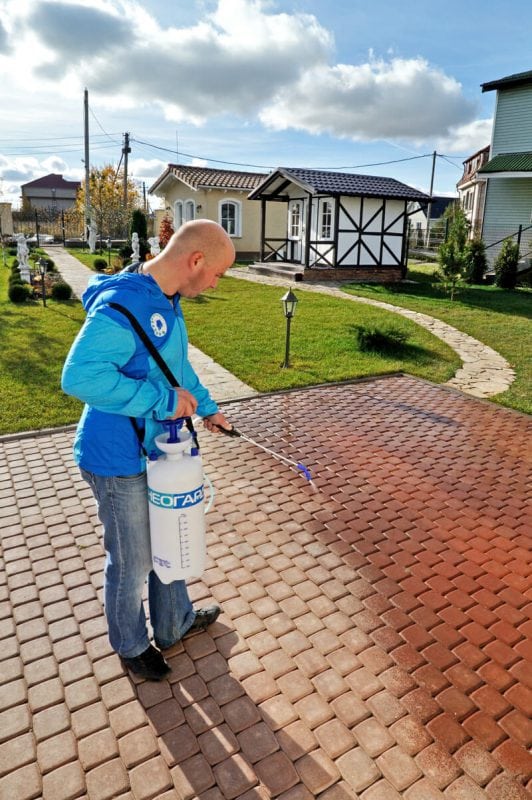Impregnation for a stone will help to cope with many problems of appearance of stone buildings. Indeed, despite the high strength, durability and reliability, the stone can also be exposed to rust or salt.
- Principle of operation
- When to use
- What you need to know about the types of drugs
- Species depending on composition
- Types depending on the effect
- Benefits
- Work rules
- How to remove rust spots
- Marble materials
- Help Chemicals

The main reason to protect the material is the corrosion of natural stone under the influence of high humidity. Consider options for removing stains and protecting the natural appearance of the material.
The stone impregnation agent is used not only for processing facades, but also for the purpose of removing rust, salt and protecting it against graffiti. The composition of a substance, as well as the principle of its action, depends on the scope of use. All of them create an invisible film on the stone, regardless of whether it is natural or artificial. This film protects stone structures from scuffs and significantly extends their life.
to contents ↑Principle of operation
The substance promotes the evaporation of moisture from the surface of a stone object and prevents it from getting inside. Water repellent fills the pores of the stone. Molecules of the substance create a special grid that prevents the penetration of water.
to contents ↑Do not forget that water-repellent impregnations will not protect against oil stains. Particles of oil freely pass through the molecular network and remain in the pores. You can avoid this problem if you use oil-based products.
When to use
Protective equipment can be useful in several cases.
- The stone is used both inside and outside the building. In both cases, it can be exposed to harmful substances. It can be various solutions with a caustic composition, household chemicals and even water. From them on the surface, for example, marble, stubborn stains may appear.
- The stone used for exterior decoration needs protection more than others. It can be affected, for example, by direct sunlight. Because of this, all the same marble can become discolored and become faded.
- Mold, moss, fungi form on the stone. Growing, these organisms can destroy the structure of the material and even the entire stone structure.
- Salt inside the stone, under certain conditions, can go outside, crystallize and destroy the material.

What you need to know about the types of drugs
Impregnation allows you to permanently maintain the attractive appearance of stone and decorative stone tiles. It will not lose its color and will not fade under the influence of direct sunlight. The film on the surface will protect the stone from the appearance of potholes, cracks and chips, make it more durable, dense.
There are compounds that can penetrate deep into the stone. They close the pores and polymerize it. Such impregnations are called hydrophobic mixtures or water repellents - they play a protective role and protect the stone from moisture. In addition, they make it resistant to petroleum products, reagents and other similar substances.
to contents ↑
Species depending on composition
- Latex impregnations help prepare stone structures for further painting.
- Chemical-based impregnations remove rust from natural and artificial stones.
- Silicone solutions protect stone products from environmental influences, make them resistant to temperature extremes.
- Impregnation without any additional effects. It is a chemical compound, sometimes silicone-based, that has the ability to penetrate the pores of a stone. Such products do not leave films, stains and smudges. Stone impregnation forms a protective layer inside. After drying, the treated surface will not differ from the surface without coating. Take, for example, granite. When applied to its surface water repellent moisture, oil and other substances will not be able to penetrate inside. They will remain on the surface and easily removed.
- Wet impregnation. This tool that takes care of the appearance of the stone, highlights its color and structure. If you cover the surface with this type of impregnation, it will get a wet shine and rich color, while there will be no film. Impregnation of wet stone is responsible for the decorative component.
- Graffiti protection. Graffiti spray paintcan be damaging to the stone. In addition, the process of its removal is fraught with some difficulties. If you cover the surface with this type of impregnation, it will not absorb paint, which, in which case, can be easily removed with the simplest cleaning agents.
Types depending on the effect
It is noteworthy that hydrophobic impregnations can be processed absolutely all stones, both natural and artificial. These are granite (porcelain tile), marble, cement stone, sandstone, gypsum. Decorative products made from these materials will benefit from the use of a water repellent.
Benefits
You can highlight the main advantages of impregnation for stone:
- Make stone surfaces as hydrophobic as possible. Granite, marble, sandstone, gypsum will not change their properties over time. They will become more resilient to weather changes and mechanical stresses.
- Corrosion of cement stone and other similar materials is a serious problem. If they are coated with a special agent, the level of corrosion resistance will increase.
- Cracks do not form inside stone products.
- The foundation and base are waterproof.
- Stone surfaces do not change their appearance for a long period of time.
- Easy to apply without additional preparation.
- Harmless.
Work rules
The application of hydrophobic agents is subject to some basic rules.
- The processing of marble, granite, gypsum and gypsum products begins with the cleaning of their surface. From them you need to remove stains from oils, tar, bitumen, salt, mold. Removal can be done using special cleaning agents.
- Depending on the type of impregnation used, the working surface should be dry or wet. For example, for silicone-based solutions, moisture is needed in order for the reaction to begin.
- Corrosion of cement stone, as well as other types of stones, leads to the formation of cracks. They must be repaired before covering the surface with a water repellent. For small cracks, just mix cement and sand. For large, epoxy is suitable.
- Concrete products (this also applies to cracked cracks) must be aged for 4 weeks before coating.
- It is important to determine whether materials and impregnation are compatible. For example, products for limestone, gypsum, granite or marble may differ in composition and principle of action. If there is doubt about the use of a particular composition, you need to conduct a test application.
- In no case do you need to dilute and in every way modify the impregnation.It must be applied from the container in which it is supplied by the manufacturer.
- Water repellents are applied with a roller or brush, you can spray them.
- Apply a thin layer of impregnation. If surplus remains, remove immediately.
- It is important that the room in which work is carried out is well ventilated.
How to remove rust spots
Sometimes rust can appear on a stone surface. How to deal with it? Using special cleaners. They are of two types:
- liquid
- pasty.
Both those and other rust removers are made on the basis of inorganic acids and anti-corrosion additives. Such cleaners are not suitable for those stones that are destroyed under the influence of acids, for example, for gypsum and gypsum structures.
to contents ↑Marble materials
Separately, the processing of marble. This natural stone has a heterogeneous structure, streaks, inclusions, cracks. Unlike granite, it is soft and easy to process. These properties affect the durability of marble products.
To fix the situation, impregnation for marble is suitable. It is easily absorbed without leaving spots and stains and without changing the appearance of the products. Such substances make marble more durable, moisture resistant, resistant to destructive factors.
Help Chemicals
Both natural and artificial stone are subject to corrosion, destruction, moisture and many other external factors. Often salt spots or rust spots form on it. Their removal is associated with difficulties, but there is a solution. Granite, porcelain stoneware, gypsum and gypsum products can be coated with a special hydrophobic impregnation, sometimes with a silicone base. It protects surfaces from moisture, rapid destruction and stains.
If stains have already appeared, rust removers can be used. All these substances have a protective and decorative function. For example, treating marble with impregnation makes its products strong, reliable and durable, and also protects against rust and other stains.









